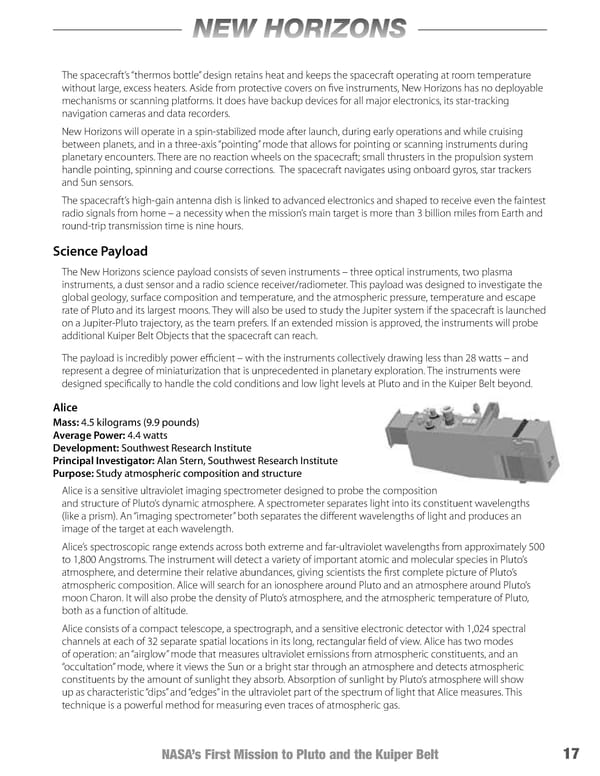NEW HORIZONS The spacecraft’s “thermos bottle” design retains heat and keeps the spacecraft operating at room temperature without large, excess heaters. Aside from protective covers on five instruments, New Horizons has no deployable mechanisms or scanning platforms. It does have backup devices for all major electronics, its star-tracking navigation cameras and data recorders. New Horizons will operate in a spin-stabilized mode after launch, during early operations and while cruising between planets, and in a three-axis “pointing” mode that allows for pointing or scanning instruments during planetary encounters. There are no reaction wheels on the spacecraft; small thrusters in the propulsion system handle pointing, spinning and course corrections. The spacecraft navigates using onboard gyros, star trackers and Sun sensors. The spacecraft’s high-gain antenna dish is linked to advanced electronics and shaped to receive even the faintest radio signals from home – a necessity when the mission’s main target is more than 3 billion miles from Earth and round-trip transmission time is nine hours. Science Payload The New Horizons science payload consists of seven instruments – three optical instruments, two plasma instruments, a dust sensor and a radio science receiver/radiometer. This payload was designed to investigate the global geology, surface composition and temperature, and the atmospheric pressure, temperature and escape rate of Pluto and its largest moons. They will also be used to study the Jupiter system if the spacecraft is launched on a Jupiter-Pluto trajectory, as the team prefers. If an extended mission is approved, the instruments will probe additional Kuiper Belt Objects that the spacecraft can reach. The payload is incredibly power efficient – with the instruments collectively drawing less than 28 watts – and represent a degree of miniaturization that is unprecedented in planetary exploration. The instruments were designed specifically to handle the cold conditions and low light levels at Pluto and in the Kuiper Belt beyond. Alice Mass: 4.5 kilograms (9.9 pounds) Average Power: 4.4 watts Development: Southwest Research Institute Principal Investigator: Alan Stern, Southwest Research Institute Purpose: Study atmospheric composition and structure Alice is a sensitive ultraviolet imaging spectrometer designed to probe the composition and structure of Pluto’s dynamic atmosphere. A spectrometer separates light into its constituent wavelengths (like a prism). An “imaging spectrometer” both separates the different wavelengths of light and produces an image of the target at each wavelength. Alice’s spectroscopic range extends across both extreme and far-ultraviolet wavelengths from approximately 500 to 1,800 Angstroms. The instrument will detect a variety of important atomic and molecular species in Pluto’s atmosphere, and determine their relative abundances, giving scientists the first complete picture of Pluto’s atmospheric composition. Alice will search for an ionosphere around Pluto and an atmosphere around Pluto’s moon Charon. It will also probe the density of Pluto’s atmosphere, and the atmospheric temperature of Pluto, both as a function of altitude. Alice consists of a compact telescope, a spectrograph, and a sensitive electronic detector with 1,024 spectral channels at each of 32 separate spatial locations in its long, rectangular field of view. Alice has two modes of operation: an “airglow” mode that measures ultraviolet emissions from atmospheric constituents, and an “occultation” mode, where it views the Sun or a bright star through an atmosphere and detects atmospheric constituents by the amount of sunlight they absorb. Absorption of sunlight by Pluto’s atmosphere will show up as characteristic “dips” and “edges” in the ultraviolet part of the spectrum of light that Alice measures. This technique is a powerful method for measuring even traces of atmospheric gas. NASA’s First Mission to Pluto and the Kuiper Belt 17
 New Horizons Page 25 Page 27
New Horizons Page 25 Page 27